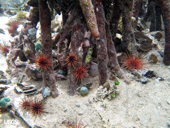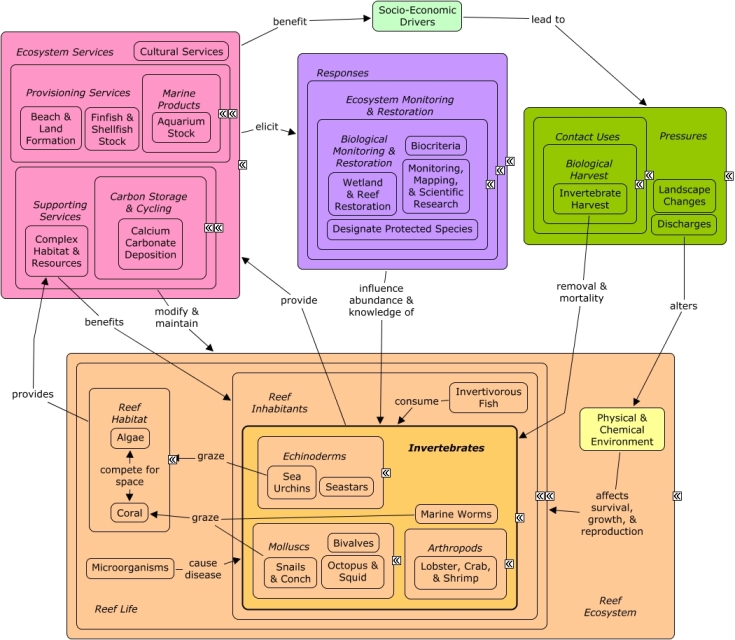ReefLink Database

Sea Urchins
Sea Urchins are small, spiny echinoderms that can be found in coral reef ecosystems. In particular, Diadema sea urchins are extremely valuable parts of reef life, because they are herbivores that prevent algae overgrowth that can kill corals.
CMap

CMap Description
Sea urchins fulfill several functions on a coral reef. Sea urchins graze macroalgae and render a critical supporting service in maintaining the reef habitat. In turn, the reef habitat provides the supporting service of complex habitat & resources. The grazing of sea urchins processes the calcium carbonate, resulting in sand & land production. Also, a few urchin species are important as aquarium stock, and all species are important to cultural services of coral reefs. Disease-causing microorganisms have decimated the sea urchin population and altered the precarious balance between echinoderm herbivores and habitat. Altering the physical & chemical environment reduces echinoderm survival, growth, and reproduction. Biological monitoring, mapping, and restoration is needed to identify changes in the abundance and condition of sea urchins; and ultimately, to determine the appropriate responses to maintain the supply of ecosystem services and ensure the benefits to human health and well-being.Citations
More than 50 citations. Click here to load.
| Citation | Year | Study Location | Study Type | Database Topics |
|---|
Management Options
| Management Option | Description | Sources | Database Topics |
|---|---|---|---|
| Monitor & Research: Biological Status and Trends Monitoring | This activity produces long-term comprehensive information on sanctuary-wide status and trends of biological resources. Data that could be collected on coral reef communities includes but is not limited to species abundance and density, biodiversity, benthic cover, coral condition, growth, recruitment, predation, and grazing. Mangroves and seagrasses should also be monitored. With adequate baseline data, changes in community structure and biocriteria can be identified and restoration or protection efforts can be taken. | NOAA Marine Sanctuary Program. 2007. Florida Keys National Marine Sanctuary revised management plan. National Ocean Service, Key West, FL. |
Algae; Anemones & Zooanthids; Apex Fish Predators; Aquaculture; Aquarium Stock; Biochemical & Genetic Resources; Biocriteria; Biological Harvest; Biological Monitoring & Restoration; Biological Monitoring, Mapping, & Scientific Research; Bivalves; Calcareous Macroalgae; Contact Uses; Coral; Coralline Algae; Cyanobacteria; Decision Support; Echinoderms; Ecosystem Monitoring & Restoration; Finfish & Shellfish Stock; Fish; Fishing Sector; Food & Energy Policies; Hydrocoral; Invasive Species; Invertebrates; Large Herbivorous Fish; Lobster, Crab, & Shrimp; Mangroves; Marine Birds; Marine Products; Marine Vertebrates; Marine Worms; Microorganisms; Molluscs; Octocoral; Octopus & Squid; Ornamental Jewelry & Art; Pathogens; Pharmaceuticals & Cosmetics Sources; Physical Damage; Primary Production; Provisioning Services; Resource Use Management; Sea Turtles; Sea Urchins; Seagrasses; Seastars; Skeletal Coral; Small Herbivorous Fish; Snails & Conch; Sponges; Stony Coral; Tunicates; Wetlands; Whales & Dolphins |
Laws
| Legal Citation | Purpose of Law | Management Organization | Database Topics |
|---|---|---|---|
| Florida Keys National Marine Sanctuary Regulations, Federal Register § Volume 66, Number 11 (2001). | NOAA established the Tortugas Ecological Reserve (a no-take zone) in the Tortugas region (Tortugas or region) of the Florida Keys to protect significant coral resources and to protect an area that serves as a source of biodiversity for the Sanctuary as well as for the southwest shelf of Florida. Establishment of the Reserve included expansion of the Sanctuary boundary to ensure that the Reserve protects sensitive coral habitats lying outside the existing boundary of the Sanctuary. Application to Coral Reefs:The Regulation protects significant coral resources and many marine species by providing a no-take zone. Legislative Actions:The regulation increased the no-take zones to 24 areas. Fishing is prohibited in Tortugas north for areas that are within State waters. Diving is prohibited in Tortugas south. Comments: |
National Oceanic and Atmospheric Administration Jurisdiction: US State Waters; Designated Marine Areas |
Biological Harvest; Bivalves; Boating Activities; Commercial Fisheries; Coral; Dive, Snorkeling, & Swimming Tourism; Environmental Education & Outreach; Finfish Harvest; Fish; Fishing & Harvesting Management; Invertebrate Harvest; Invertebrates; Lobster, Crab, & Shrimp; Marine Protected Areas; Molluscs; Octopus & Squid; Recreational Fishing; Reef Habitat; Reef Inhabitants; Sea Urchins; Seastars; Snails & Conch; Sponges; Stony Coral; Tourism & Recreation; Trawling & Fishing Gear Damage |
